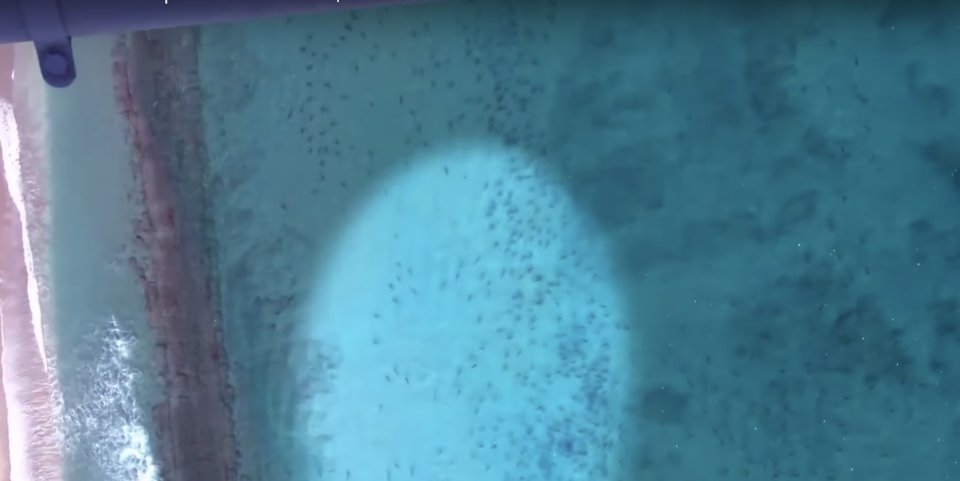The popular beach where every swimmer is just 'metres from a shark'
A popular US beach has been dubbed the shark attack capital of the world, with tens of thousands of the predators skulking near the shore.
Lurking underneath the pristine blue waters of Florida’s New Smyrna Beach are an alarming number of sharks posing a significant risk to the swimmers and surfers that frequent the spot.
It is the scene of one in every 25 shark attacks worldwide – according to the International Shark Attack File (ISAF), the world’s only scientifically documented database of all known shark attacks – with people mostly falling victim to blacktip sharks.
There have been as many as 20 shark attacks in one year at the beach and in August last year alone, there were three attacks there in just 24 hours.

CNN reported a 20-year-old surfer was bitten on her left hand and wrist while a 21-year-old was attacked on his right foot just 30 minutes later.
Less than 24 hours later, a 51-year-old man was bitten by what he described as a 1.2-metre shark when he was knee-deep in the beach.
Eerie drone footage of the beach posted on YouTube also shows dark shadows in the water stalking unsuspecting swimmers, showing just how close they’re lurking.
Dr Stephen Kajiura, from the Florida Atlantic University, told National Geographic an aerial survey of the coastline showed tens of thousands of blacktip sharks in a narrow band near the shore, as they migrate to Florida for the winter.

“There are hundreds of thousands of blacktips making this migration along the coast every year,” he said.
“These sharks hug the shoreline, they might be doing that to stay away from predators.
“We have thousands of them so close to shore right along the beach where the bathers are.”
National Geographic reports the ISAF estimates that every swimmer on average comes within three metres of a shark at New Smyrna Beach.
Boy crashes into shark while surfing
One boy had a terrifying encounter with a predator while surfing at the shark capital in December last year.
Shaun Moore posted to Twitter an incredible photo of the moment his seven-year-old son Chandler collided with the blacktip and was knocked off his board.
He was lucky to escape injury.
“God was looking out for you, you could have been badly hurt!” one person commented on Twitter.
According to an interactive map that shows the odds of being attacked in different hotspots across the world, developed by Casino.org, Florida has the highest rate of shark attacks in the US with almost 1000 occurring in the state since 1900.

Data from the company provided to Yahoo News Australia revealed there were 21 attacks at New Smyrna Beach alone in 2001, 12 in 2002, 2003 and 2007 and 20 in 2008.
There were five attacks a year from 2009 to 2011, rising again to 12 in 2016.
There were seven reported attacks at the beach last year. But none of the attacks have been fatal.
Australia has second most shark attacks in 2019
According to the International Shark Attack File’s Yearly Worldwide Shark Attack Summary, 21 of 64 unprovoked shark attacks in 2019 in the world were in Florida alone.
The most attacks recorded to date in Florida, 312, occurred in Volusia county where New Smyrna Beach is located.
Australia had the second highest number of shark attacks in 2019, with the ISAF recording 11.
Since records began, there have been 253 attacks in NSW, 195 in Queensland, 98 in Western Australia, 41 in South Australia, 40 in Victoria and seven in the Northern Territory.
Life-saving act as shark swam towards kids
Mr Moore is not the only parent whose child has encountered a shark at the beach.
During a trip to Florida’s New Smyrna Beach last year, photographer Dan Watson decided to take photos of his kids playing in the ocean with his drone – an act that proved to be possibly life-saving.
As he watched a live feed streaming back to his phone from the drone, he started seeing a shadow moving through the water.
He immediately yelled “shark!” as his children, 3 and 5, were swimming unaware.
“I was screaming at my wife, who is a little bit closer to the kids, and we’re running out to get them and yelling at them to get in,” Mr Watson told Buzzfeed News US.
“During that moment, I was worried they wouldn’t get out in time ... from what I was seeing, and it was moving fairly quickly.”
According to Florida Museum blacktips prefer to forage in shallow waters that are less than 30 metres deep, meaning people often encounter them.
“This has resulted in a few bites that are cases of mistaken identity where the shark mistakes a swimmer, or a surfer’s arm or leg for a prey item,” the museum says on its website.
Only one blacktip attack has been fatal, with most resulting in only minor injuries.
They get their name from the black markings on the top of their fins.
Do you have a story tip? Email: newsroomau@yahoonews.com.
You can also follow us on Facebook, Instagram and Twitter and download the Yahoo News app from the App Store or Google Play.



